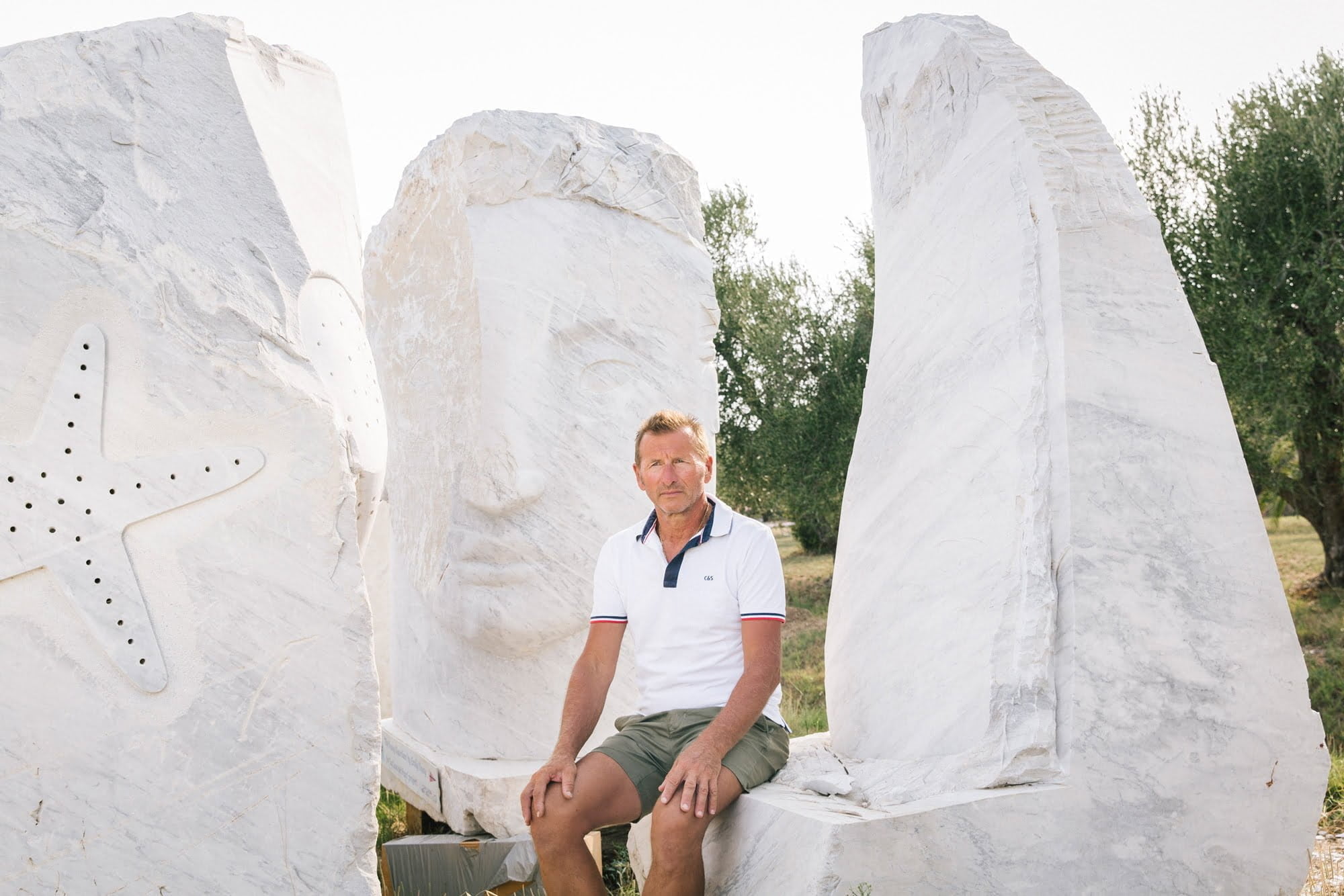Often we think of nature and culture as separate things. Yet, it’s amazing what you can achieve when you combine the two. That is why we invited a set of acclaimed international artists to channel their creativity and help protect the marine ecosystem of the Mediterranean.
As part of our inaugural artist-in-residence programme, we invited 15 professional artists and rising stars to create a finished piece inspired by their time in the French Riviera – a setting that has drawn some of art’s biggest names for over a century.
The finished artworks were recently sold at a special auction organised by 5. And with a grand total of €77,300 – the auction proved that when it comes to raising funds and awareness, art can be a tremendous tool. Proceeds will go to Casa dei Pesci – an NGO with a creative solution to illegal trawling: using giant submerged sculptures to keep the boats at bay. Part sanctuary, part underwater art museum, it was founded by local fisherman Paolo Fanciulli (main image) to protect the waters of the Mediterranean and provide a place for sea life to thrive.
Casa dei Pesci has already lowered 39 sculptures and marble blocks onto the sea bed to begin their underwater activism as stony sentinels. Another 12 are ready and will no doubt join them as soon, thanks to the extra funding.
“Art and the environment are closely connected. Artists have to be very sensitive to carry out their art, and this awareness gives them close attention to nature and its protection. We are very grateful for this donation to give us the budget we need to protect our seas,” said Giovanni Contardi, Casa dei Pesci president, responding to news of the amount raised at auction.
Contributing artists and their work
Tom Anholt
“During the residency I worked on a new series of flower paintings which is a running theme. The vase is from the house and the flowers are from the area. During the process I made four oil paintings and this one watercolour. The image remains the same, the colours change through the series.
My works often focus on landscapes and environments. I am a passionate supporter of protecting the environment. Any artist is dealing with the human condition and how humans inhabit the world, we have a responsibility to highlight these issues and help in any way we can.”

‘French Flowers’, 2022, watercolour on paper, 24 X 19cm

Tom Anholt. Photo: courtesy of the artist
Victor Bengtsson
“The artwork I have donated is a pastel, oil colour and charcoal sketch of one of my recent works called ‘Prodigal Daughters of Phage’. The painting depicts two daughters being speared by the arms of a large-scale bacteriophage – believed to be the most common entity in the biosphere and a undisputedly necessary organism for our Existence.
The daughters find themselves is a verdant yet slightly gloomy garden, where large-scale bacteria and flowers are indistinguishable. The prodigal daughters are based on the sculpture ‘The Prodigal Son’ by Rodin which illustrates the ‘Parable of the Prodigal Son’ from the Bible, where a son squanders his inheritance recklessly, and is forced to return home and beg his father for forgiveness. The two daughters are holding hands, united in both pleasure and pain: the pleasure and pain of being co-emerged with the extensive life and unavoidable death in the biosphere.”
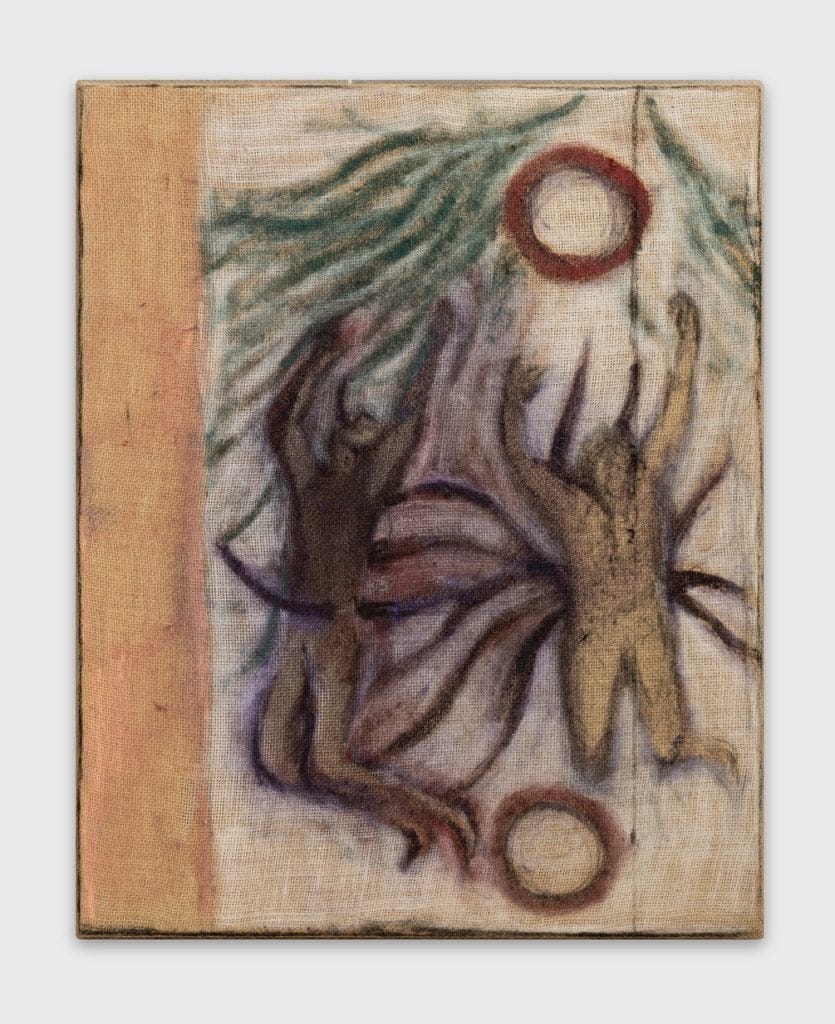
Untitled, 2022. oil on jute

Victor Bengtsson. Photo: courtesy of the artist
Keith Boadwee
Having studied under Paul McCarthy, Chris Burden, Roger Herman and Charles Ray at UCLA in the late 1980s, Boadwee has maintained a longstanding interest in artistic practice that is both performative and socially transgressive.
Working extensively between performance documentary, photographic self-portraiture, collage, drawing and oil painting over the past four decades, Boadwee’s works combine the aesthetics of cartoon humour with a radically queer sensibility. His work is often directly concerned with sexual taboo, the psychology of domesticity and an overwhelming desire to upset propriety – both as it pertains to art-historical ‘good taste’ and heteronormative social structuring.
Boadwee has exhibited extensively between Los Angeles, New York and Europe. His work is included in the collections of the Museum of Contemporary Art, Los Angeles (MOCA) and in exhibitions at the The New Museum of Contemporary Art, New York, among others.
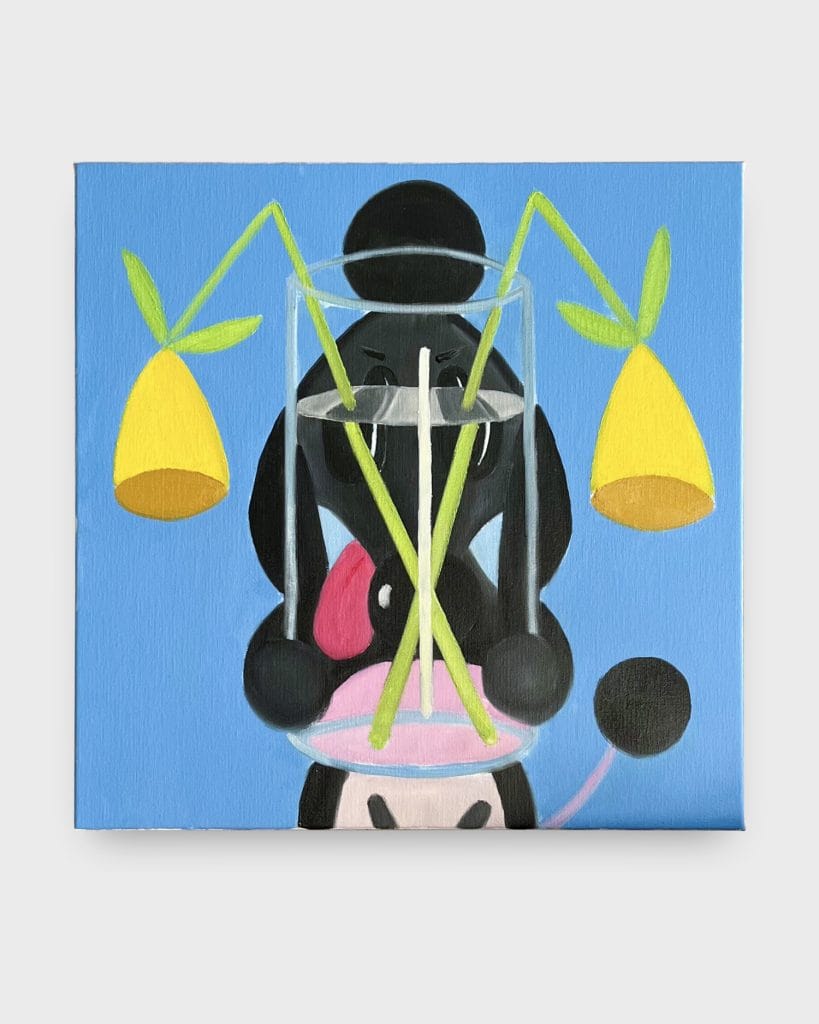
Untitled, 2022, oil on linen 50 x 50cm
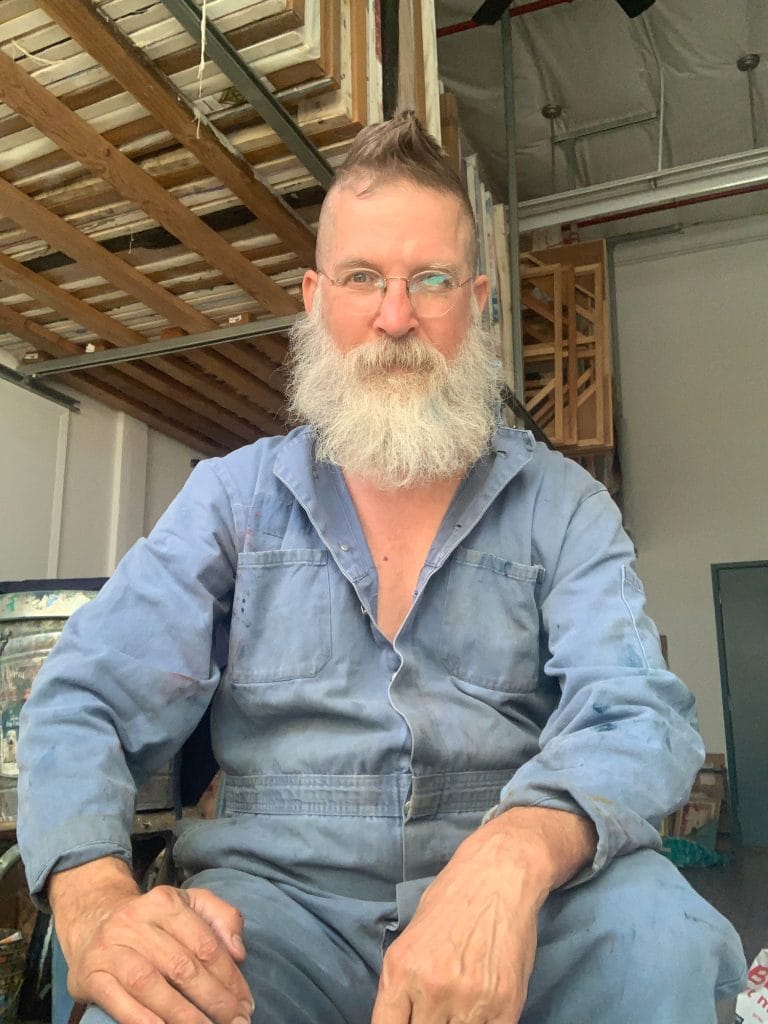
Keith Boadwee. Photo: courtesy of the artist
Simon van Deurs Formann
Producer, composer, researcher and educator. Simon van Deurs Formann is an active releasing, recording and performing artist, solo and in a myriad of different constellations. He has presented his work in the EU, Asia, USA and Russia since 2012. He has been teaching digital composition and performance at the Rhythmic Music Conservatory in Copenhagen since 2019 and has done audiovisual installations at Kunsthal Charlottenborg, Copenhagen and spacial audio installations at MONOM, Berlin.
The foundation of his work is an exploration of global club music archeology, community ecology, esoteric distribution and everything fringe. This research explores and navigates themes like recontextualisation, memory, agency, nostalgia vs. immediate future and modern media-specific realities.
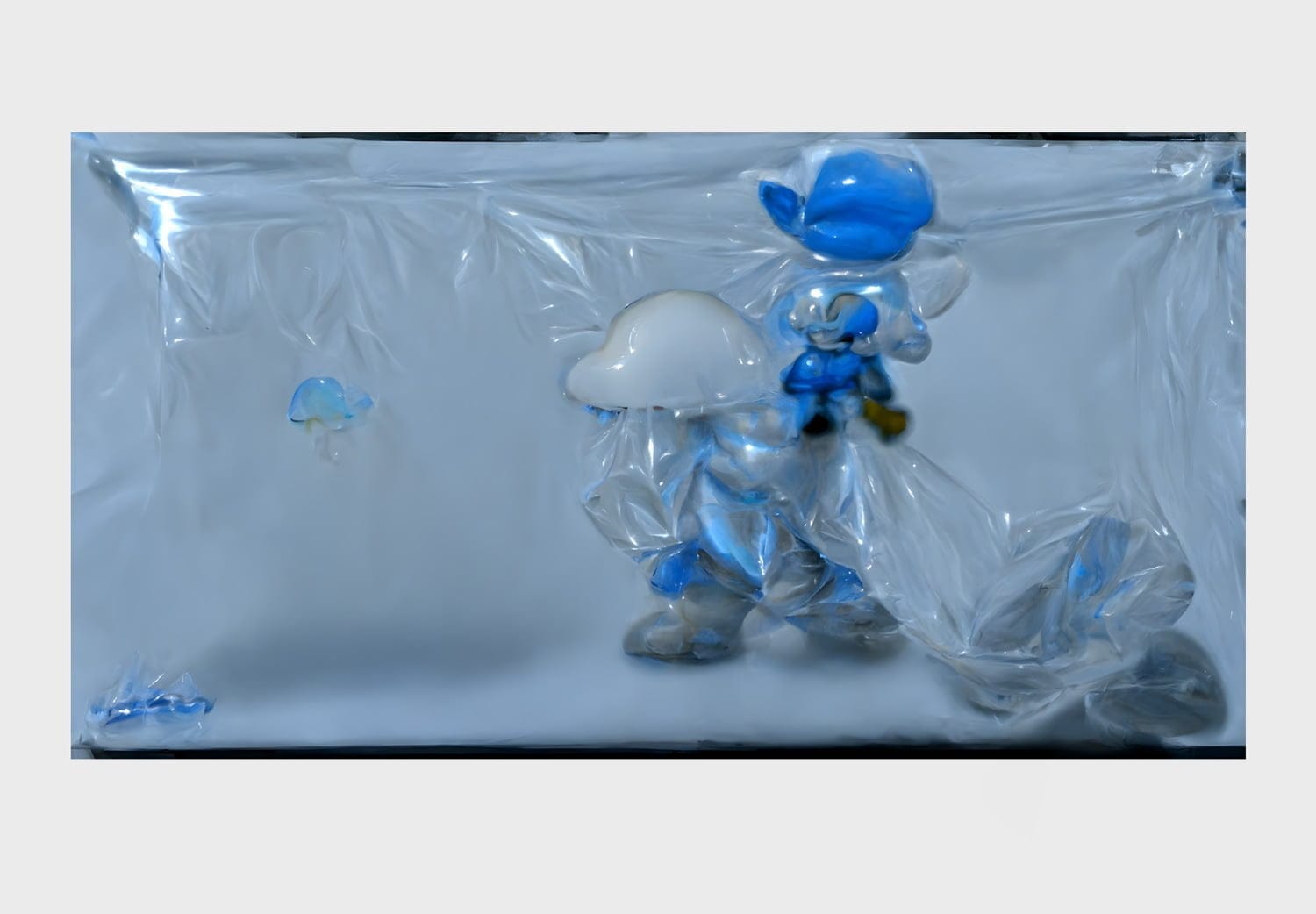
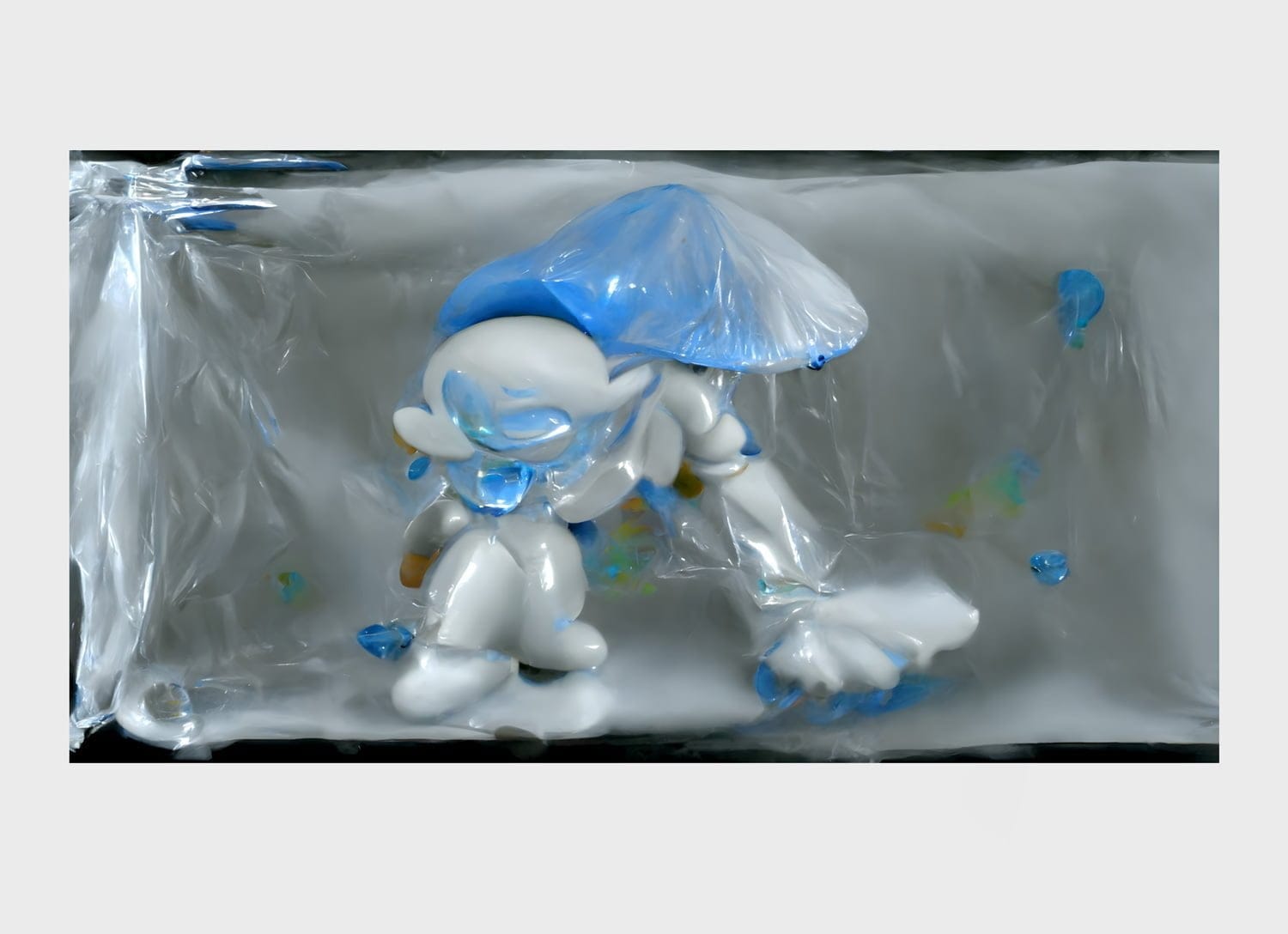




Kevin Josias
“To keep a critical approach to everything around you is one of the most important things in general and I hope that my work reflects that as well.
I donated two pieces. They are both sketches or work studies. The first piece consists of two interlinked tin castings depicting a human body shaped as a chain link. Jewellery has been an essential part of self decoration for thousands of years, which had me investigating the relationship between metals and the human body. The repetition of the shape points to the question of individuality.
Work number two is a tin casting that resembles a snakeskin imprinted purse. The piece was made by creating a plaster mould around existing imitated snakeskin. Afterward the molten tin was poured into the mould and lightly manipulated into shape. Two snakeskin pieces are held in place with a chain shoulder strap. This sculpture imitates a functional fashion item that also thematically centres around our ways of manifesting identity using props.”
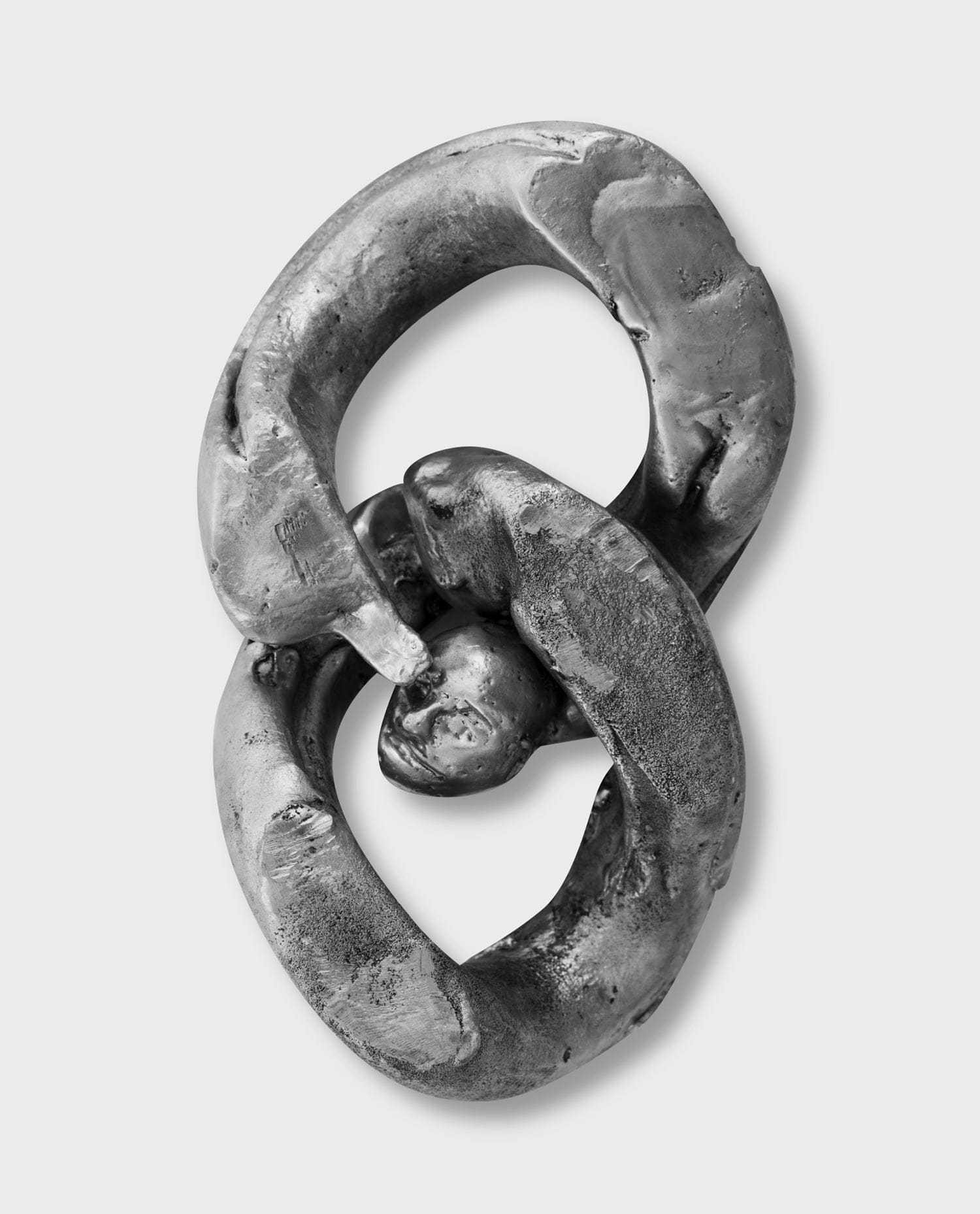
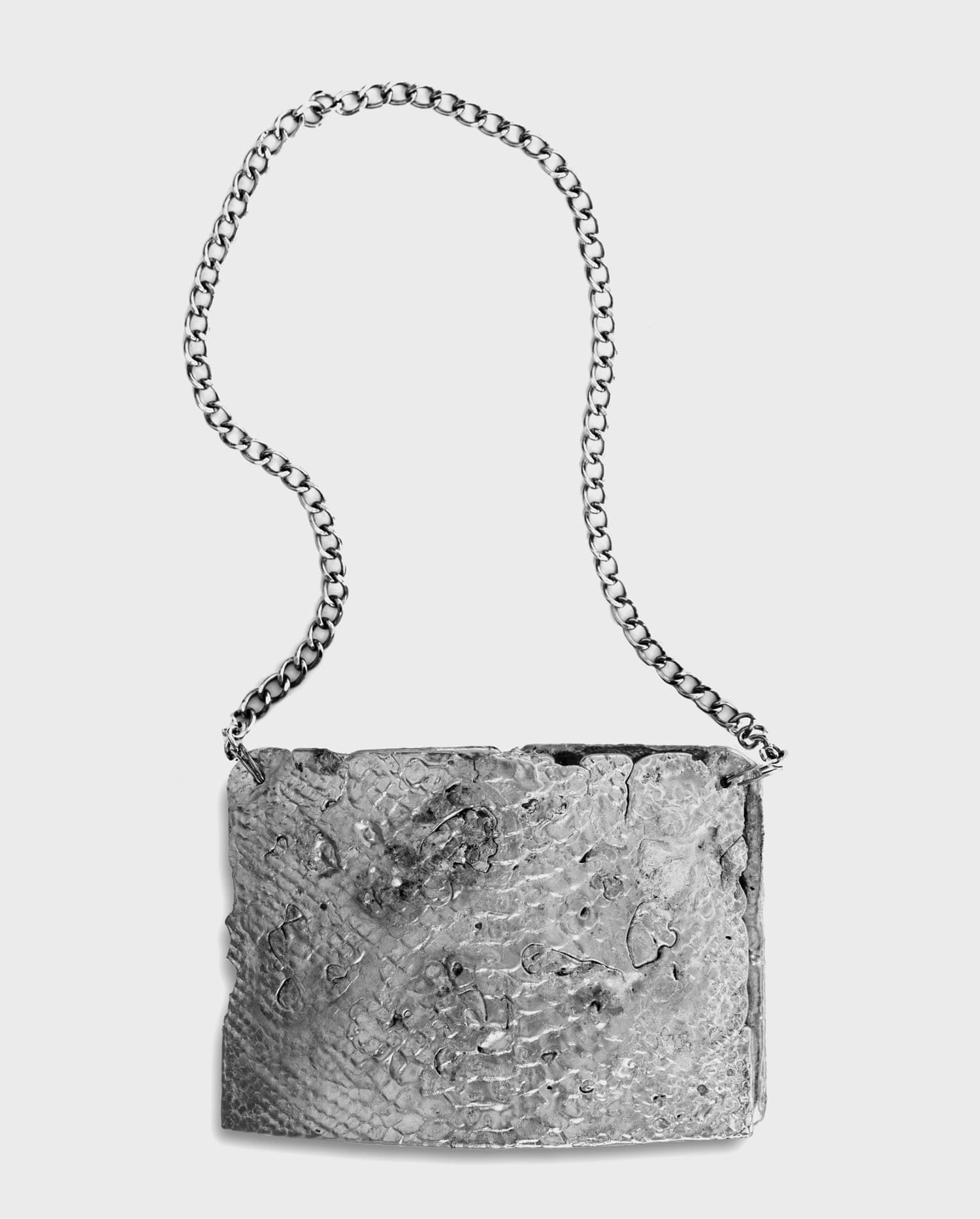
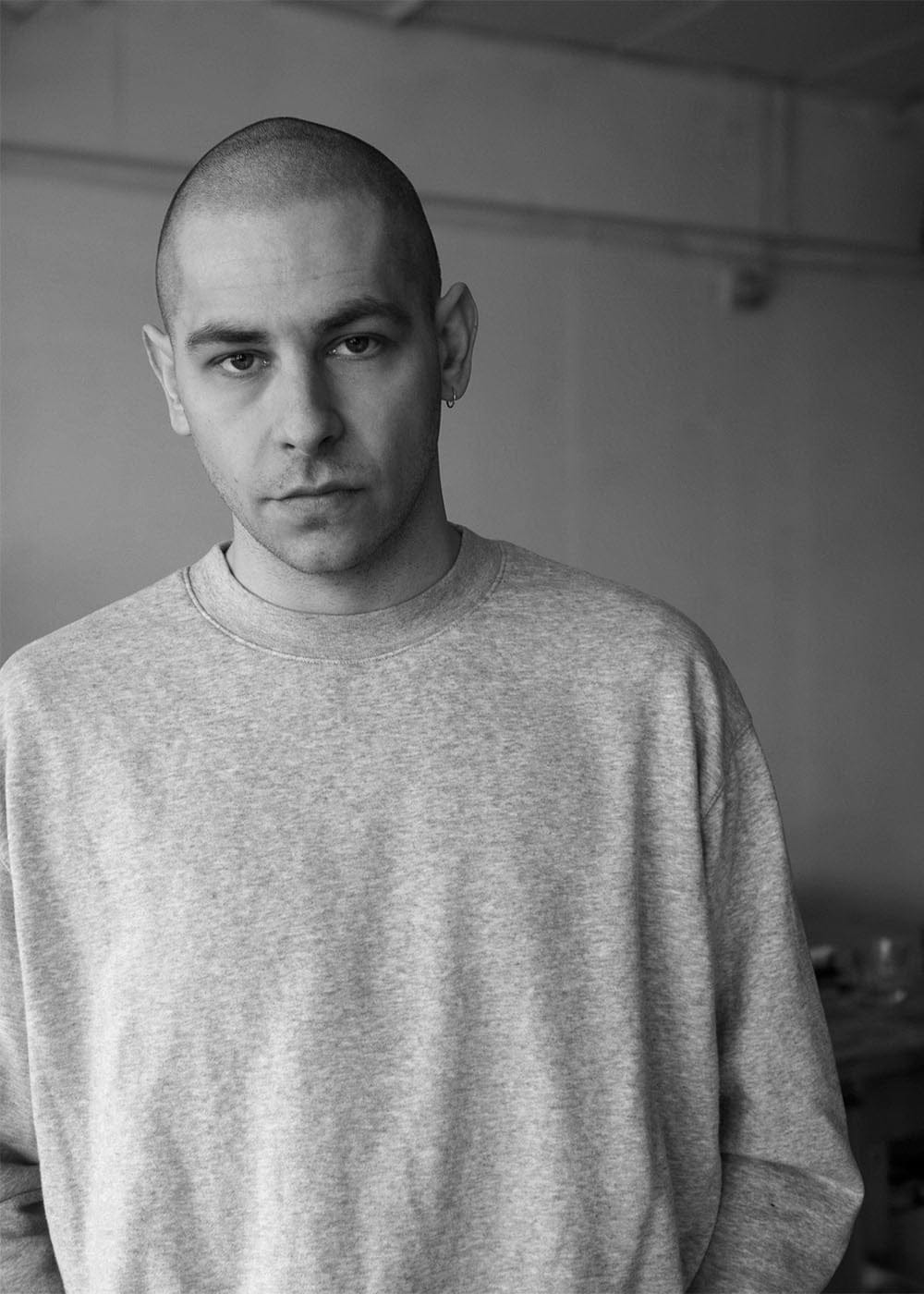



Pierre Knop
“I’m a landscape painter with a great interest in abstract painting. Sounds like paradox but it isn’t. I’m focused on the possibilities to deconstruct and rebuild a painting’s surface with diverse media and to connect painting with drawing. Being influenced by the New York School of the 1950s, the intuitive workflow is essential to me and brings the relation of unconscious decisions, mistakes and coincidence to the table of painting. The spectator or recipient may decode my painting as a landscape but for me it is more an orchestra of several multi-media moments.”
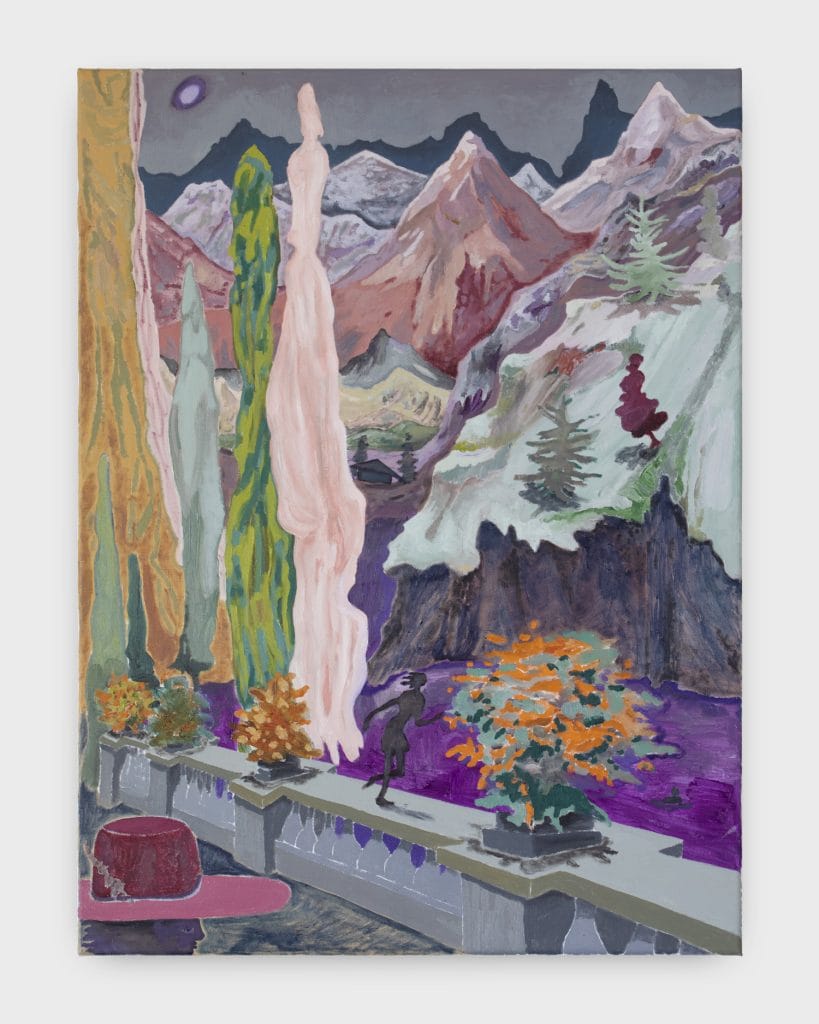
Untitled, 2022, oil on canvas
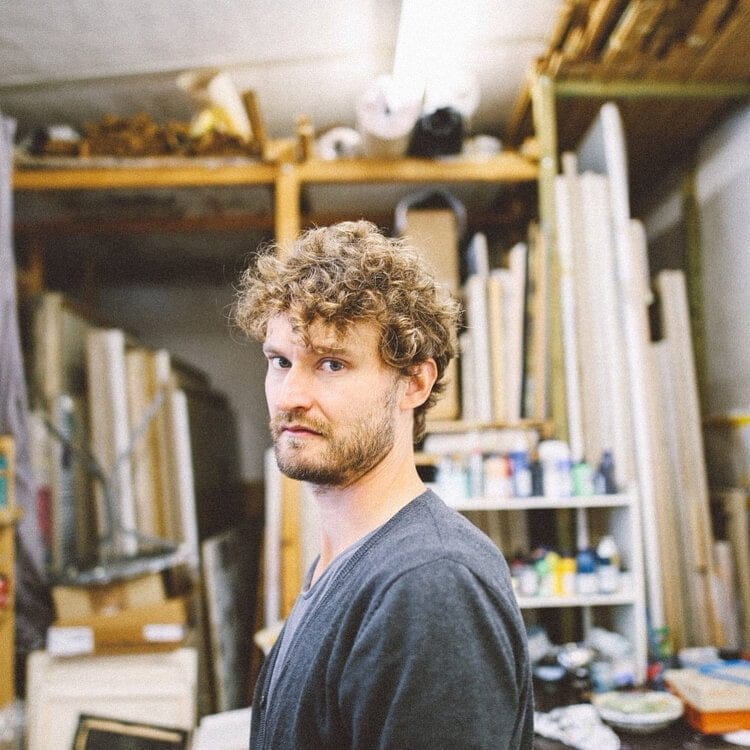
Pierre Knop. Photo: courtesy of the artist
Igor Moritz
“My paintings tend to be made from life, centering around people, places and things from my closest surroundings. By looking at what could be considered the mundane, I hope my work touches upon the general themes and feelings of the human experience; such as uncertainty, longing and anticipation.
The most important [response] for me would be for the viewer to be able to take the time to Look… and that the work resonates with something they are currently going through in their life.”
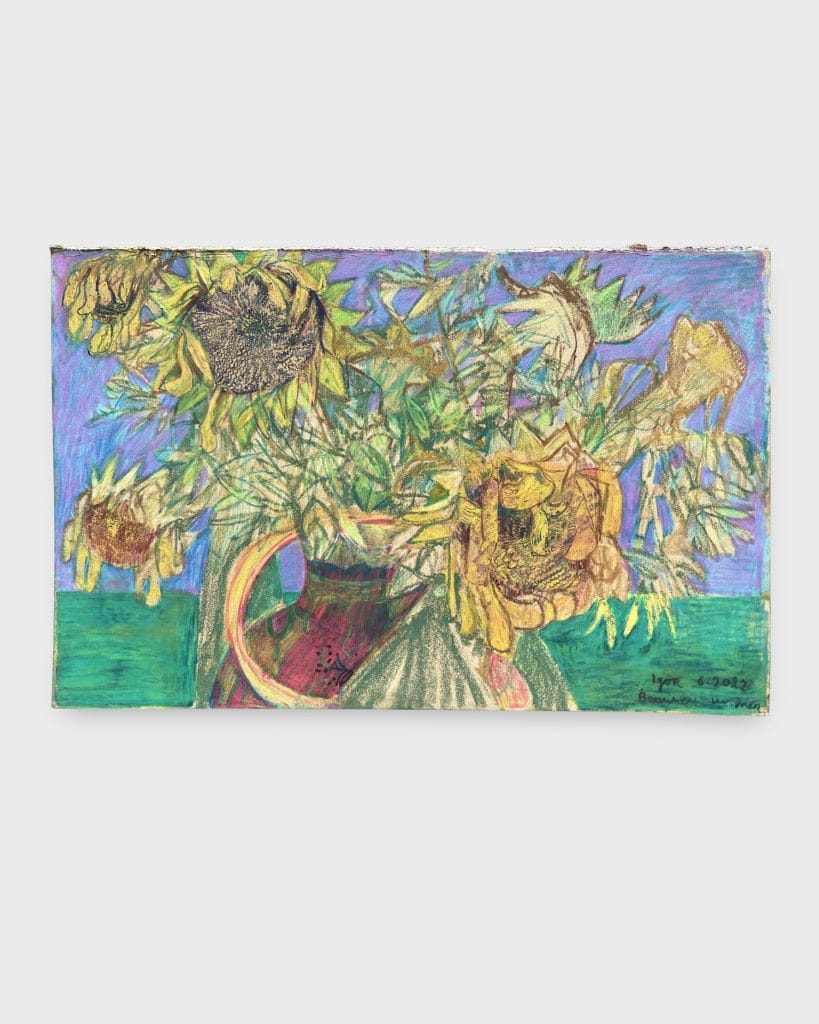
Untitled, 2022
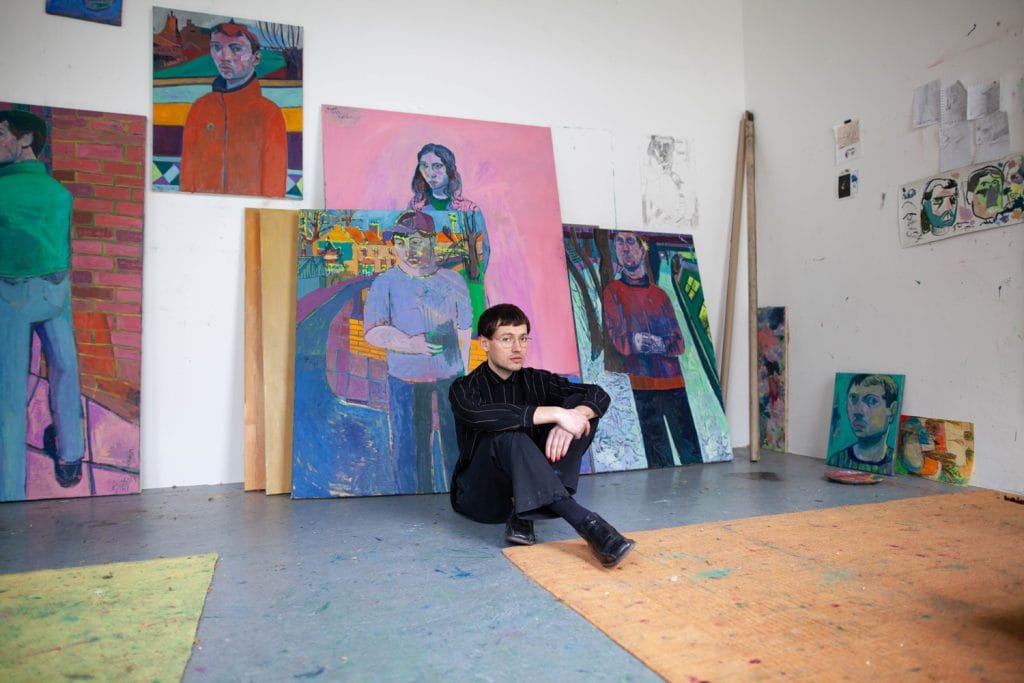
Igor Moritz. Photo: Brynel-Odu-Davies
Eva Helene Pade
“I’ve donated a painting titled ’Sketch of a Smile’. The grin of pain mirrors the smile of laughter as the grotesque turns satirical in the theatre of life. At the end of reason awaits chaos and absurdity. Faced with meaninglessness, rationality falls away.
My focus on the complexity of interrelationships finds its roots in a tradition of painting that includes the Expressionist masters. This also extends to the audiences’ position as viewer, which shifts and is used in different ways within my work.
In some paintings, it’s as if the viewer is invited to join in, encouraged to become part of a narrative that started before their arrival and will continue once they leave. In other works, it feels as if the viewer is strictly made to be an observer or voyeur allowed to look in from the outside or as if you were never intended to see it at all – as if you opened a door at a party and accidentally walked in on something private. Inversely, some works feel as if these roles are swapped and that it is the people in the paintings who are in fact observing you, peering directly into your own life.”

‘Sketch of a Smile’, 2022, oil on panel

Eva Helene Pade. Photo: Åsmund-Sollihøgda
Emma Stern
Emma Stern’s work deploys her formal background in traditional oil-on-canvas painting to achieve a kind of contemporary portraiture made possible by 3D software. Using tools intended for game developers to create virtual female models that serve as her subjects, her work emphasises and exacerbates the apparent inclination towards pornographic (or at least porn-adjacent) representations of women in 3D communities and gaming culture.
Her subversive take on figurative art techniques studied from Caravaggio and Michelangelo bridges the masters and the digital age in a pastel universe of voluptuous characters—all of whom embody sexual tropes and likenesses often found within Reddit’s NSFW chatrooms or hentai, a niche sub-genre of animated pornography that gets more internet searches than Obama, Marvel, or The New York Times. Combining traditional painterly techniques such as monochromatic underpainting and chiaroscuro with virtual modelling tools, Stern creates eerily anonymous, finely-worked ‘portraits’, reclaiming these man-made avatars for the female domain.

Untitled, 2022

Emma Stern. Photo: Josef Forselius, courtesy of Carl Kostyál
Chloe Wise
“My work is multi-media and explores a number of themes… consumerism, the body, art history, the banal.
Environmental change isn’t something we can choose to find interest in, it’s our reality, and it should compel everyone who inhabits this planet to act. I think about my consumption and the waste I produce and try to manage that, but it’s obviously not enough, which is why I’m always interested in ways art can organise to raise awareness or funds for good causes, especially on the local level.”

Untitled, 2022
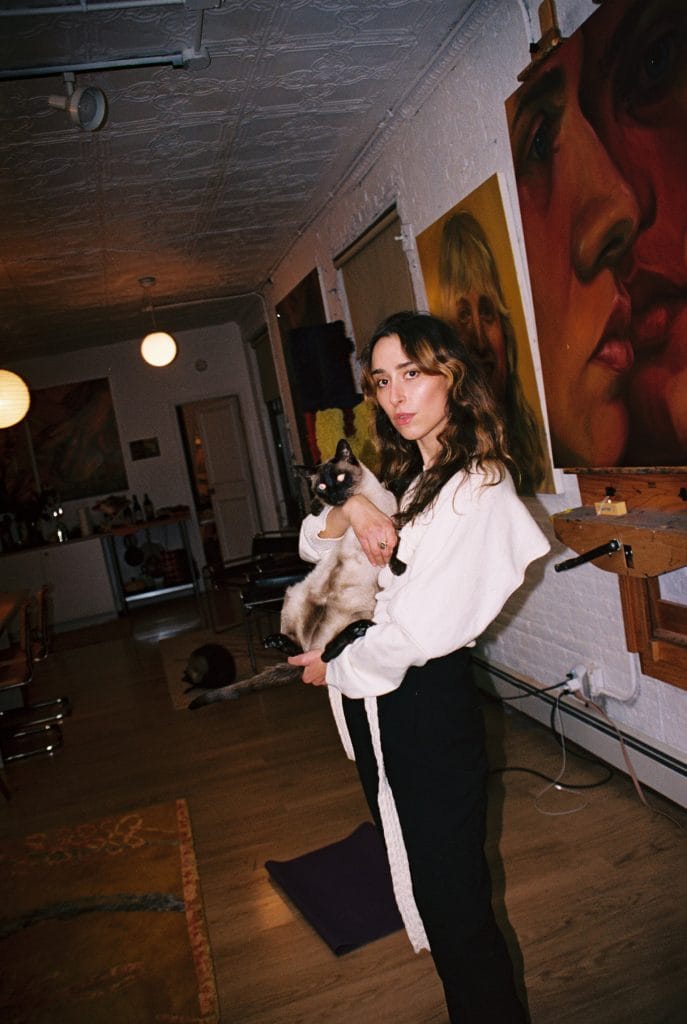
Chloe Wise. Photo: Richie-Shazam
Ane Cornelia Pade
As an art historian and curator, Ane Cornelia Pade’s finished work is a piece she wrote, inspired by her residency.
“I arrived in Beaulieu-sur-Mer weary from sleepless nights and the English weather. My mind clouded by half formed thoughts and the confines of Cambridge’s cloistered colleges. When I climbed the stairs to the Villa on the first night, the sun had long since set. The early rays of sunrise woke me up the following morning and revealed the blue of the Cote d’Azur tinted by the pale pink of dawn, like watercolours blending on a piece of paper. On mornings such as that, Homer’s line about the rose fingered Eos comes to mind. I drank coffee with Eva on the terrace overlooking the sea. We sipped our coffee and warmed our winter skin, as the rose tint of early morning gave way to the endless blue of the sea – forgoing the horizon and spilling into the spring sky. We continued to do so every morning for the duration of my stay, rising early and drinking coffee in the first morning sun.
I sat on the terrace reading and writing while Eva painted. From time-to-time short bursts of conversation interrupted our silent concentration: “What do you think of this figure?”, “This page makes an interesting point”. The books that occupied me during my stay in Beaulieu explored the history of mirrors in European thought and the role of conversation in French salon culture. To philosophers, the mirror has always presented the possibility, for better or worse, of recognising oneself.
The mirror provides access to our exterior, always visible to others but concealed from our own eyes, and allow us to better understand our own interiority through contemplation of the exterior self. The refined art of conversation perfected in France in the 17th and 18th century was made possible by mirrors. The mirror allowed salon-goers to rehearse and perfect the gestures and facial expressions that accompanied their words in conversation. A slight smile, a tilt of the head, a gesture of the hand, or a tone of voice animates and lends flavour to conversation in a way the written word can never achieve.
The greatest thinkers of the French enlightenment believed that thoughts and ideas could only truly be known and developed through conversation. Left to simmer alone in the mind, our thoughts are only half known to us. Like the mirror’s reflexion which permits the philosopher to explore the inner self, so we need the reflexion of another to make our thoughts complete. Through the responses of a conversation-partner, the questions they ask, the ideas they present, and their physical expression as they hear and contemplate our thoughts and ideas, we come to know the extent of our own mind. I always talk to Eva about my research, and she always asks my opinion on her paintings. Through these conversations we both come to better understand our thoughts and the expression they take in our work.
Inspiration works much like conversation, and one will often emerge from the other. The blue waters and yellow sunshine of the Cote d’Azur has long been a source of inspiration for artists, writers, and thinkers. On our long walks along the coast, chance led us to encounter great works of art. Jean Cocteau’s Chapel Saint-Pierre in Villefranche-sur-Mer appeared as an unexpected gift on a morning walk and made us consider the expressiveness of confidently drawn lines. In Villa Eprussi de Rothschild, likewise a chance discovery, I found works by Clodion which once adorned the facade of a Hôtel Particulier in Paris that I happen to research. Villa Kerylos overwhelmed me with its dedication to antiquity. As an Art Historian who spends every day thinking about the lives and thoughts of people in the past, I felt an affinity for both the knowledge and nostalgia of the villa. And so, I entered into conversation with the surroundings and found room for new ideas to form.”
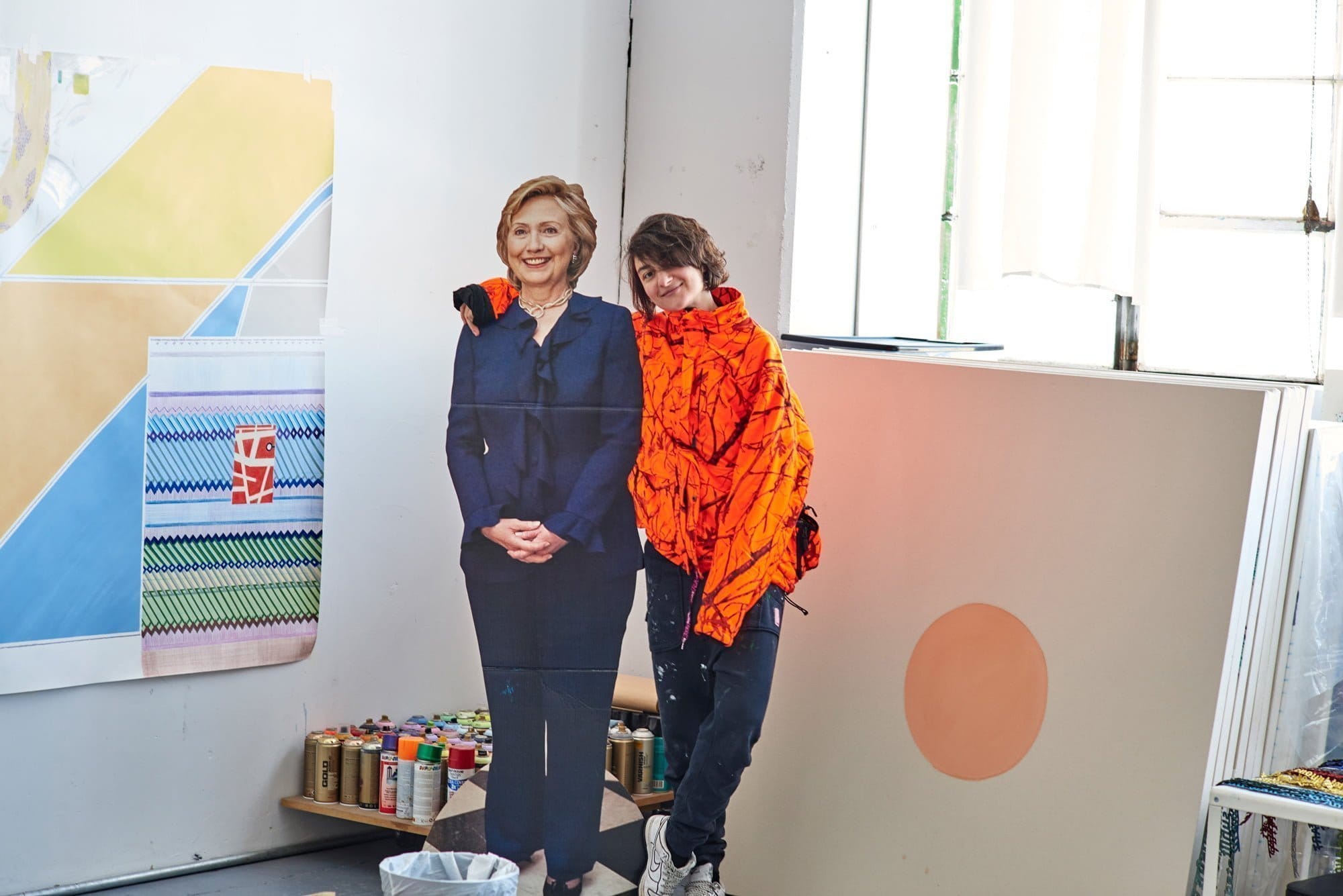
Ane Cornelia Pade. Photo: Ryan-Slack
